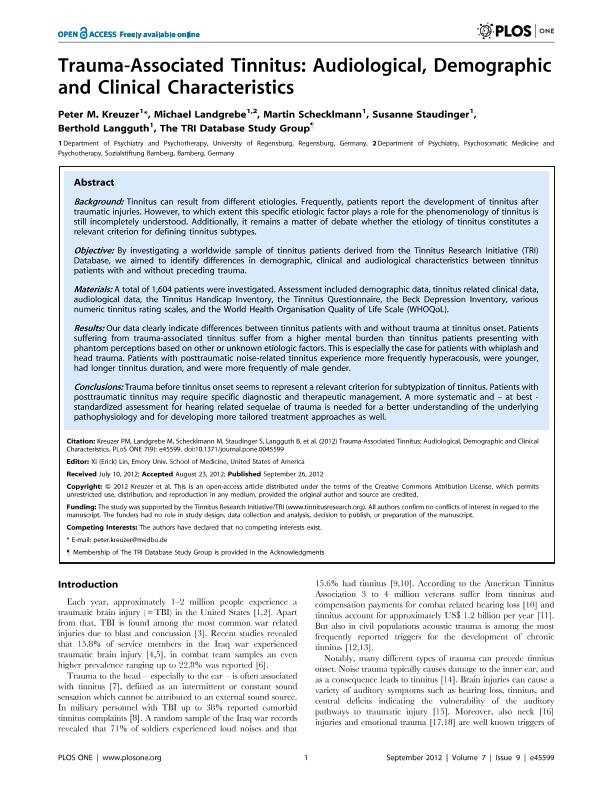Mostrar el registro sencillo del ítem
dc.contributor.author
Kreuzer, Peter M.
dc.contributor.author
Landgrebe, Michael
dc.contributor.author
Schecklmann, Martin
dc.contributor.author
Staudinger, Susanne
dc.contributor.author
Langguth, Berthold
dc.contributor.author
Vielsmeier, Veronika
dc.contributor.author
Kleinjung, Tobias
dc.contributor.author
Lehner, Astrid
dc.contributor.author
Poeppl, Timm B.
dc.contributor.author
Figueiredo, Ricardo
dc.contributor.author
Azevedo, Andréia
dc.contributor.author
Binetti, Ana Carolina
dc.contributor.author
Elgoyhen, Ana Belen

dc.contributor.author
Rates, Marcelo
dc.contributor.author
Coelho, Claudia
dc.contributor.author
Vanneste, Sven
dc.contributor.author
de Ridder, Dirk
dc.contributor.author
van de Heyning, Paul
dc.contributor.author
Zeman, Florian
dc.contributor.author
Mohr, Markus
dc.contributor.author
Koller, Michael
dc.date.available
2019-07-29T19:16:36Z
dc.date.issued
2012-09
dc.identifier.citation
Kreuzer, Peter M.; Landgrebe, Michael; Schecklmann, Martin; Staudinger, Susanne; Langguth, Berthold; et al.; Trauma-Associated Tinnitus: Audiological, Demographic and Clinical Characteristics; Public Library of Science; Plos One; 7; 9; 9-2012; 1-9
dc.identifier.issn
1932-6203
dc.identifier.uri
http://hdl.handle.net/11336/80506
dc.description.abstract
Background: Tinnitus can result from different etiologies. Frequently, patients report the development of tinnitus after traumatic injuries. However, to which extent this specific etiologic factor plays a role for the phenomenology of tinnitus is still incompletely understood. Additionally, it remains a matter of debate whether the etiology of tinnitus constitutes a relevant criterion for defining tinnitus subtypes. Objective: By investigating a worldwide sample of tinnitus patients derived from the Tinnitus Research Initiative (TRI) Database, we aimed to identify differences in demographic, clinical and audiological characteristics between tinnitus patients with and without preceding trauma. Materials: A total of 1,604 patients were investigated. Assessment included demographic data, tinnitus related clinical data, audiological data, the Tinnitus Handicap Inventory, the Tinnitus Questionnaire, the Beck Depression Inventory, various numeric tinnitus rating scales, and the World Health Organisation Quality of Life Scale (WHOQoL). Results: Our data clearly indicate differences between tinnitus patients with and without trauma at tinnitus onset. Patients suffering from trauma-associated tinnitus suffer from a higher mental burden than tinnitus patients presenting with phantom perceptions based on other or unknown etiologic factors. This is especially the case for patients with whiplash and head trauma. Patients with posttraumatic noise-related tinnitus experience more frequently hyperacousis, were younger, had longer tinnitus duration, and were more frequently of male gender. Conclusions: Trauma before tinnitus onset seems to represent a relevant criterion for subtypization of tinnitus. Patients with posttraumatic tinnitus may require specific diagnostic and therapeutic management. A more systematic and - at best - standardized assessment for hearing related sequelae of trauma is needed for a better understanding of the underlying pathophysiology and for developing more tailored treatment approaches as well.
dc.format
application/pdf
dc.language.iso
eng
dc.publisher
Public Library of Science

dc.rights
info:eu-repo/semantics/openAccess
dc.rights.uri
https://creativecommons.org/licenses/by-nc-sa/2.5/ar/
dc.subject
Tinnitus
dc.subject
Phantom Perception
dc.subject.classification
Medicina Critica y de Emergencia

dc.subject.classification
Medicina Clínica

dc.subject.classification
CIENCIAS MÉDICAS Y DE LA SALUD

dc.title
Trauma-Associated Tinnitus: Audiological, Demographic and Clinical Characteristics
dc.type
info:eu-repo/semantics/article
dc.type
info:ar-repo/semantics/artículo
dc.type
info:eu-repo/semantics/publishedVersion
dc.date.updated
2019-07-10T13:40:01Z
dc.journal.volume
7
dc.journal.number
9
dc.journal.pagination
1-9
dc.journal.pais
Estados Unidos

dc.journal.ciudad
San Francisco
dc.description.fil
Fil: Kreuzer, Peter M.. Universitat Regensburg; Alemania
dc.description.fil
Fil: Landgrebe, Michael. Universitat Regensburg; Alemania
dc.description.fil
Fil: Schecklmann, Martin. Universitat Regensburg; Alemania
dc.description.fil
Fil: Staudinger, Susanne. Universitat Regensburg; Alemania
dc.description.fil
Fil: Langguth, Berthold. Universitat Regensburg; Alemania
dc.description.fil
Fil: Vielsmeier, Veronika. The TRI Database Study Group; Alemania
dc.description.fil
Fil: Kleinjung, Tobias. The TRI Database Study Group; Alemania
dc.description.fil
Fil: Lehner, Astrid. The TRI Database Study Group; Alemania
dc.description.fil
Fil: Poeppl, Timm B.. The TRI Database Study Group; Alemania
dc.description.fil
Fil: Figueiredo, Ricardo. The TRI Database Study Group; Alemania
dc.description.fil
Fil: Azevedo, Andréia. The TRI Database Study Group; Alemania
dc.description.fil
Fil: Binetti, Ana Carolina. The TRI Database Study Group; Alemania
dc.description.fil
Fil: Elgoyhen, Ana Belen. Consejo Nacional de Investigaciones Científicas y Técnicas. Instituto de Investigaciones en Ingeniería Genética y Biología Molecular "Dr. Héctor N. Torres"; Argentina. The TRI Database Study Group; Alemania
dc.description.fil
Fil: Rates, Marcelo. The TRI Database Study Group; Alemania
dc.description.fil
Fil: Coelho, Claudia. The TRI Database Study Group; Alemania
dc.description.fil
Fil: Vanneste, Sven. The TRI Database Study Group; Alemania
dc.description.fil
Fil: de Ridder, Dirk. The TRI Database Study Group; Alemania
dc.description.fil
Fil: van de Heyning, Paul. The TRI Database Study Group; Alemania
dc.description.fil
Fil: Zeman, Florian. The TRI Database Study Group; Alemania
dc.description.fil
Fil: Mohr, Markus. The TRI Database Study Group; Alemania
dc.description.fil
Fil: Koller, Michael. The TRI Database Study Group; Alemania
dc.journal.title
Plos One

dc.relation.alternativeid
info:eu-repo/semantics/altIdentifier/doi/http://dx.doi.org/10.1371/journal.pone.0045599
dc.relation.alternativeid
info:eu-repo/semantics/altIdentifier/url/https://journals.plos.org/plosone/article?id=10.1371/journal.pone.0045599
Archivos asociados
